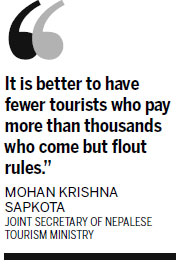Tragedy shakes Nepal's faith in tourism
German tourist Tobias Pantel is determined to leave soon on a five-day hike in the Annapurna region, the very place where dozens were killed by a freak blizzard and avalanches in Nepal's most deadly trekking disaster.
As the search for dozens still missing on the snow-covered Himalayan slopes continues, and relatives around the world wait in desperation for news of their loved ones, more foreigners are preparing to hit the trail.
"It was a natural accident that could take place anywhere," said Pantel as she sat outside a Kathmandu hotel, sipping beer and smoking with her husband. "I want to go to the area because it is very beautiful. I don't think the storm will come next time."
Every year, thousands of adventure tourists like Pantel set out on treks in the spectacular heights around Annapurna, the world's tenth-highest peak. But many have little or no previous experience on mountains, and many are young backpackers who are cavalier about the risks and tend not to hire trained guides.
Now, even as it faces a barrage of criticism for failing to warn trekkers about the storm rolling in, Nepal's government is having doubts about its thousands of shoestring-budget tourists.

"It is better to have fewer tourists who pay more than thousands who come but flout rules," said the tourism ministry's joint secretary, Mohan Krishna Sapkota.
Such an idea may be unworkable, though, with one critic warning that any restrictions would hurt an economy heavily reliant on tourism, and another critic questioning the logic given plans to open new routes to trekkers.
"They are opening new peaks to foreign climbers, so where is the question of limiting anyone?" said Elizabeth Hawley, a US national who has lived in Nepal since 1960 and chronicles major mountain expeditions.
Since the Oct 13 storm, the army has pulled 30 bodies out of thick snow. Nepalese, Israeli, Canadian, Indian, Japanese, Slovak and Polish trekkers are among the dead.
The Annapurna Conservation Area Project, a government body that registers the entry and exit of tourists in the northwestern ranges of Nepal, said it had records of only 120 tourists on the trekking route when the blizzard hit.
But more than 400 people have been brought to safety.
"We had no idea that so many people were trekking there," said Junu Thapa, an ACAP officer. "Foreign tourists should register and not venture out on their own with local boys who pretend to be professional guides."
(China Daily 10/21/2014 page11)














